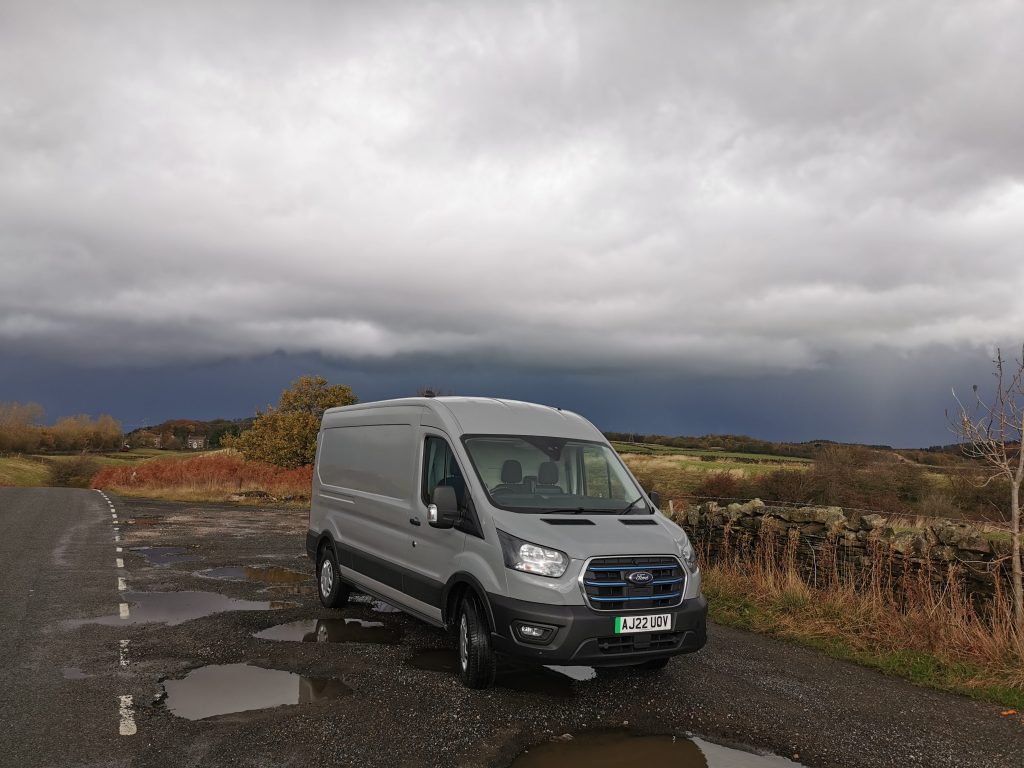Ford E-Transit Review
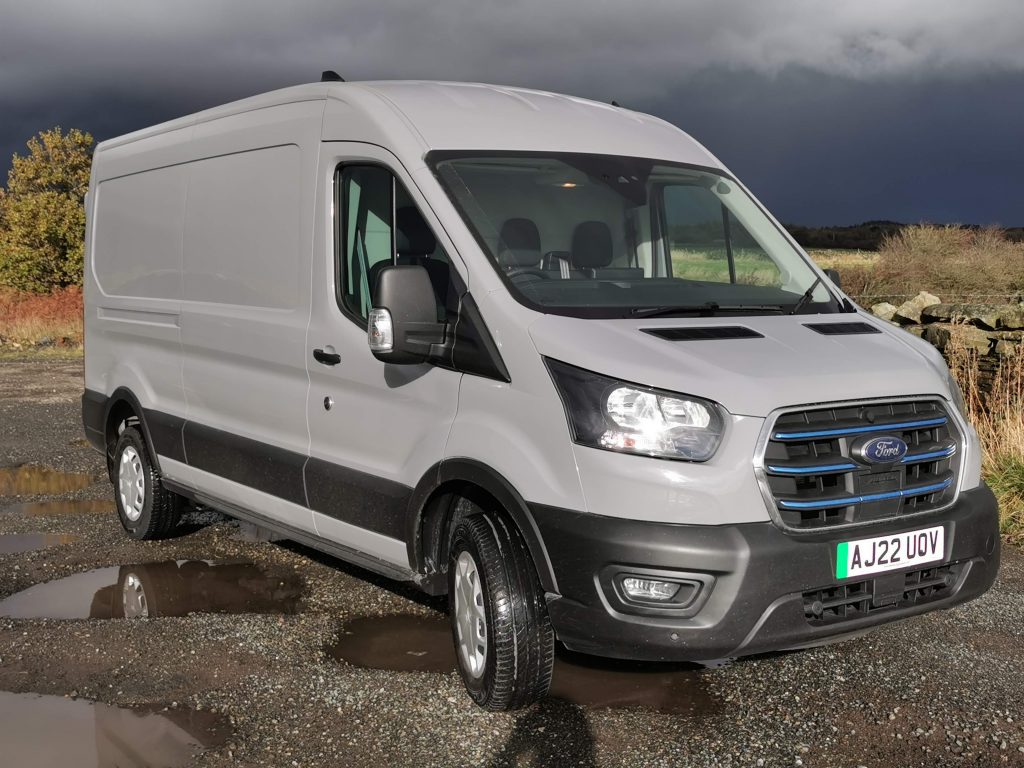
Although Ford Pro has been a little slow in getting off the mark with electric commercial vehicles, the announcement of a forthcoming E-Transit, an all electric version of its best selling ‘2 tonne’ large van in the autumn of 2020 took the van world by surprise. Not with its timing, but by the combination of power output, range, payload and price that the E-Transit promised.
It’s taken some time to come to market but with customers now having taken delivery of the first models I’ve now had an opportunity to spend a week with a van that many, including myself vaunted as a ‘game changer’. The E-Transit is visually identified by the blue front grille inserts, and with the van in diesel form being familiar to many, and, as I reviewed the Transit in its latest guise back in 2020 this article will major on the new aspects that the E-Transit brings along.
The Range
E-Transit is available 25 model variants, including a van in three lengths, two heights, and three GVM’s (including a 4.25t version to take advantage of the government’s licensing dispensation for electric vans allowing a driver with just a car licence to drive the van providing a short amount of training is taken). There are also double cab in van and chassis cab versions, and the two trim levels of Leader and Trend offer an equipment level higher than that of the diesel powered equivalents.
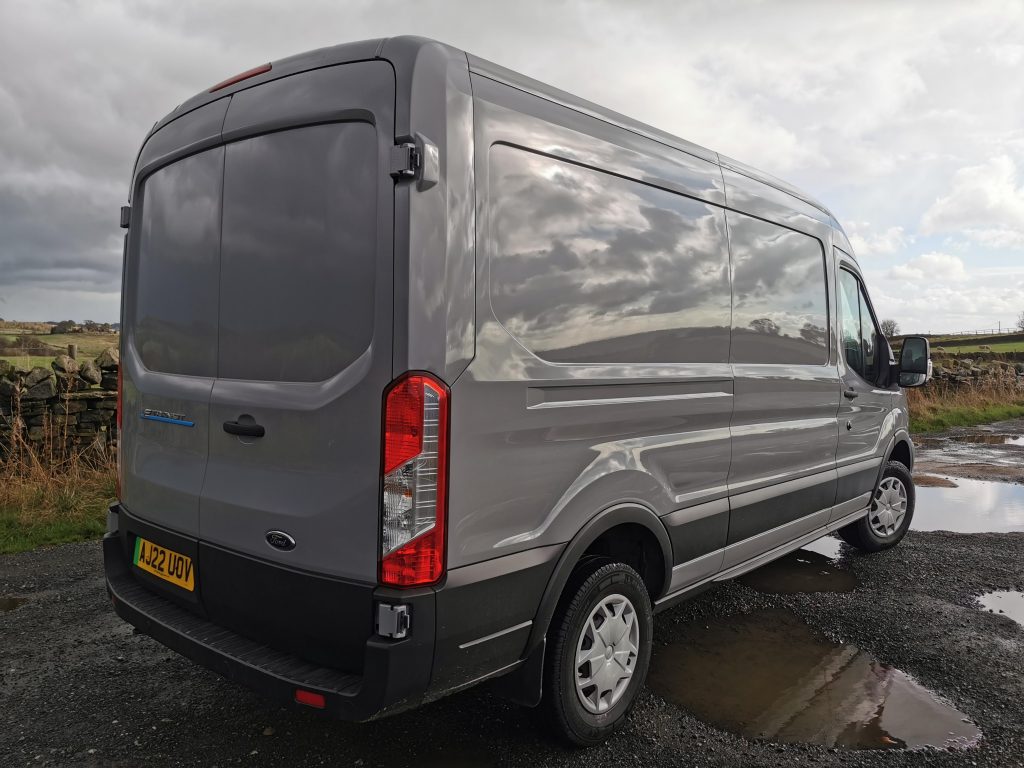
Power and Battery Options
The 68kWh battery pack is mounted under the van floor in between a redesigned independent rear suspension layout with no impact on the load bay or loading height. This fuels a single motor which drives the rear wheels, there being a choice of two power outputs equivalent to either 184hp or, a positively outrageous 269hp. There’s an onboard charger capable of accepting up to 11.3kW of AC power, allowing a zero to 100% charge time of just 8.2 hours. The van can accept DC charge rates of up to 115kWh, find a public chargepoint capable of this and you’ll get back from 15% to 80% of capacity in 34 minutes.
The E-Transit is supplied with an 8 metre Type 3 charge cable, and the charge point on the van is behind a flap in the centre of the front grille with a set of lights displaying the charge status and warning of any faults.
The range achieved on the WLTP combined test cycle is a very impressive 196 miles, more than double that some competitor vans in the same sector can offer. Ford Pro is at pains to remind customers that in the real world the van won’t be able to cover that distance due to traffic conditions, weather and loads being carried and has very fairly suggested that 100 miles should be achievable under the very worst combination of range draining factors.
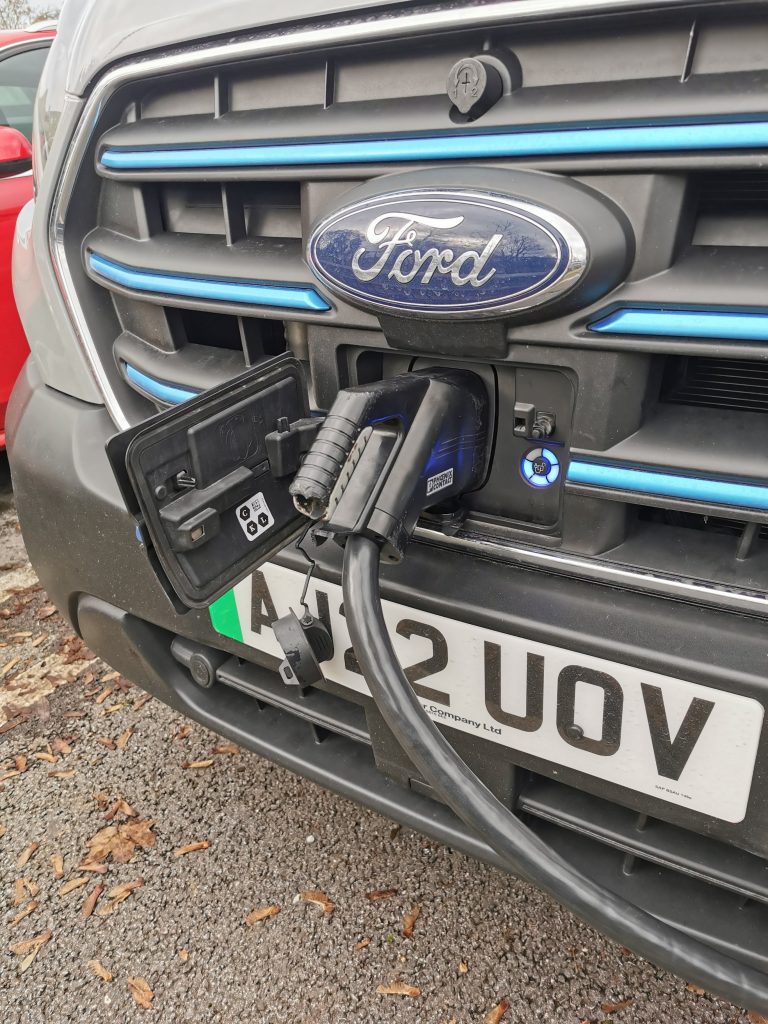
Payloads
With the 4.25t van, payloads of up to 1758kg are available, but the more familiar 3.5t versions can carry from 709kg to 1035kg, depending on the model – significantly under the diesel Transits capability due to the weight of the battery pack and motor assembly, but competitive when put against offerings from other manufacturers. Towing is only permitted on the 3.5t GVM van and is limited to a braked trailer of 750kg.
The cab
E-Transit inherits the high quality cab from the diesel Transit. It’s made of durable materials clearly capable of taking some harsh treatment. The dash contains plenty of storage areas with additional capacity in the doors and in an overhead tray.
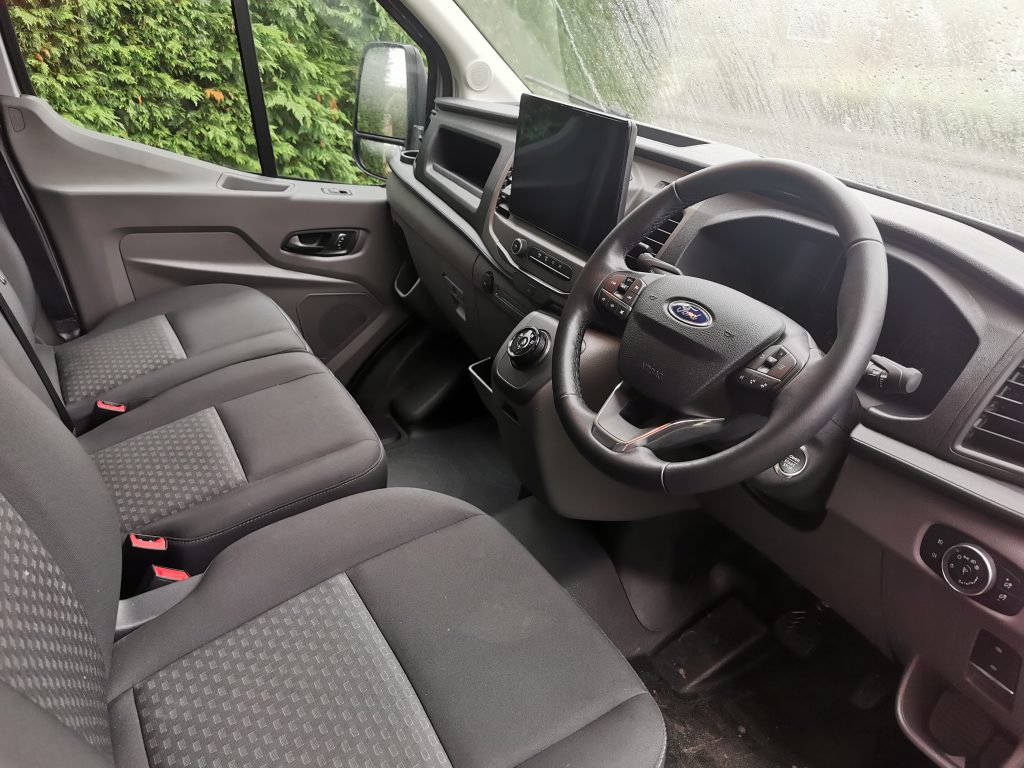
Dominating the dash is a 12 inch touchscreen which features the very latest version of Ford’s multimedia and control centre solution, the SYNC4. Allowing control of the DAB radio, other digital inputs, Bluetooth connections and even the air conditioning, the unit offers Apple CarPlay and Android Auto smartphone integration together with fully featured satellite navigation. Not only this, the screen allows the driver to select one of three driving modes. Normal is the default, but Eco optimises the range available by reducing performance and limiting other functions such as air conditioning. Crucially, if selected the Eco setting is retained, even when the vehicle is left and then restarted, something that could otherwise irritate drivers who wish to remain in that mode on a daily basis. Slippery improves traction in low grip conditions by increasing the effect of the ESC system and smoothing the inputs from the throttle. The screen will also give the driver feedback on driving style, with a view to improving efficiency.

Preconditioning of the cab environment is controlled by the touchscreen, letting the driver programme the vehicle via a timer to heat or cool the cab prior to departure. This can also be done remotely via the FordPass Pro app, allowing the driver or fleet manager to condition the vehicle whilst it is still on charge, saving on battery power and vehicle range. Pre-conditioning can also be applied to the battery, ensuring that the pack is at the optimum working temperature before departure.

The instrument panel has a multifunction display informing the driver of remaining range and other data. What was the fuel gauge now gives an indication of remaining charge, and instead of a rev counter, a large dial shows how much power is being used or, when slowing down or descending a gradient, the amount of charge being regenerated and fed back into the battery.
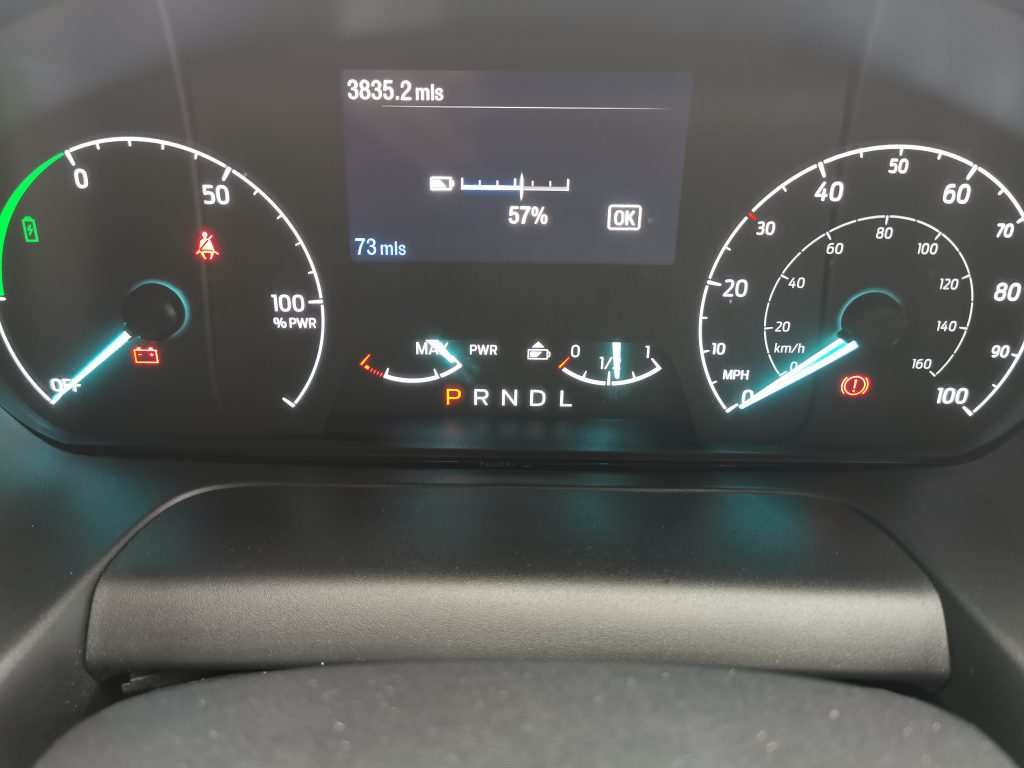
Pro Power Onboard
Although not standard equipment, the E-Transit can be specified with Pro Power Onboard, delivering up to 2.3 kW of power for tools and equipment, in many cases avoiding the need for an additional on board generator. There are two 3-pin sockets in the loadspace with a third between the driver and passenger seats.
Equipment level.
The test van was the Trend model, which has a decent amount of spec. There’s air conditioning, cruise control, a heated windscreen, and an electric parking brake. Front and rear parking sensors help to avoid those knocks and scrapes, and standard safety equipment includes Collision Mitigation, Side Wind Mitigation, Lane Departure Warning and Emergency Brake Warning systems.
On The Road
A press of the keyless start button sees the dash displays come to life together with an odd click and whirr. There’s a rotary dial on the dash which is turned to select drive, reverse, park etc, with a central button marked ‘L’ which, when activated, increases the braking effect of the motor, allowing for additional power recuperation on long or steep descents.
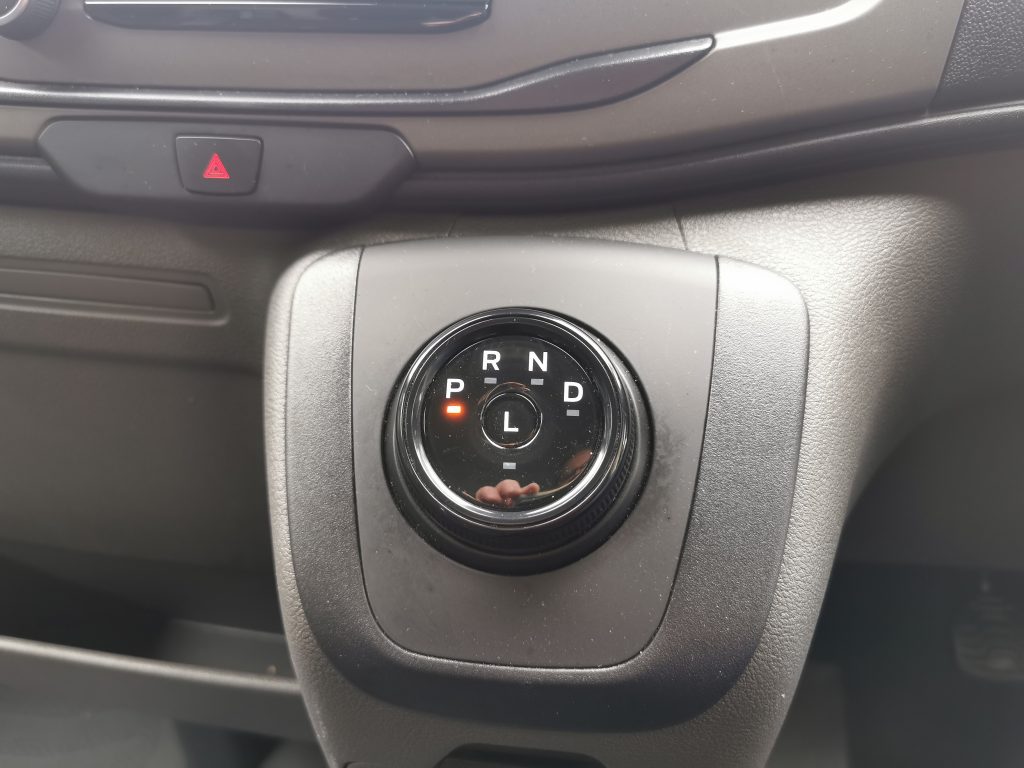
A turn to the D position and gentle pressure on the accelerator sees the van pull away, almost silently. Plant it to the floor and you’re hit with acceleration you’ve almost certainly never experienced in a van, the E-Transit capable of winning many traffic light Grand Prix’s against some decent cars. The performance is quite phenomenal, partly thanks to the immediate availability of 430Nm of torque. My test van was the lower powered version so quite how startling the difference would be with an additional 85PS I can only imagine.
As I’d come to expect with any modern Ford commercial vehicle, noise and vibration intrusion into the cab is minimal, and, bear in mind that the quiet electric drivetrain in any vehicle tends to highlight other sources of sound, this is no mean feat. The E-Transit feels refined, not just in this aspect but in the excellent build quality which is indefinable but apparent everywhere.
The only significant criticism I have is of the SYNC4 display. Not the functionality of the unit, but its positioning. Whilst a central mounting point is probably unavoidable, in a large van this means it’s quite a distance from the driver. Many vans now have the screen angled slightly toward the driver and this makes all the difference. The E-Transit’s display directly faces the rear of the van and this looks and feels odd, making operation particularly when driving less than easy. It’s something that may well have been overlooked, or possibly discounted for cost reasons allowing for uniformity when building left and right hand drive vans.
Running Costs
Ford Pro has stated that over a 3 year or 100,000 mile period, service, maintenance and repair (SMR) costs for the E-Transit will be 40% lower than the equivalent diesel engined models. There’s an annual service with no limit on mileage and the warranty is 3 years / 100,000 miles, but with 8 years cover on the battery and all other high voltage components (the battery on van models being guaranteed to retain 70% of its capacity).
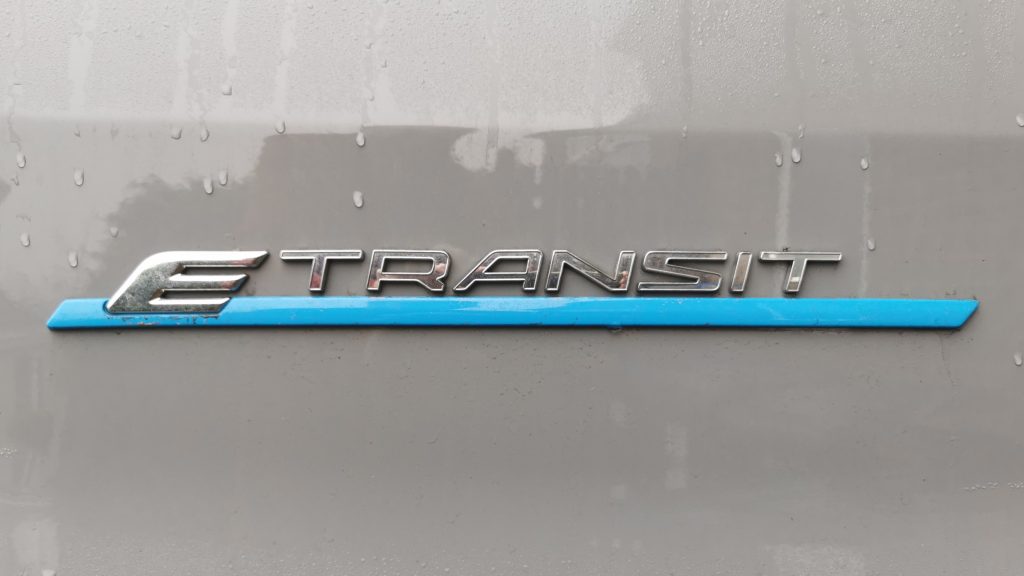
Conclusion
The E-Transit’s arrival instantly made pretty much all large electric vans from other manufacturers obsolete overnight. With a large number of models available, customers are not being forced into a van unsuitable for their operation. The range is great, payloads are competitive and from a driver’s perspective the experience is unparalleled. Ford Pro may have taken its time, but it has got it right. And with the arrival of the E-Transit Custom using the same powertrain in the not too distant future, manufacturers such as the Stellantis group which has pretty much owned the electric medium van sector up until now will be nervously looking over their shoulders…
